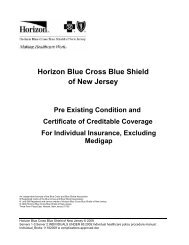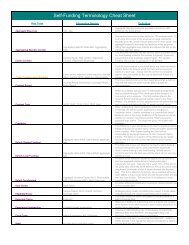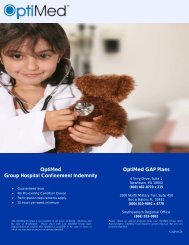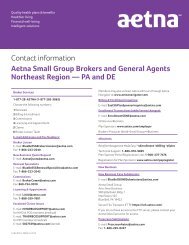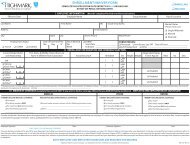Self-Funding Terminology Cheat Sheet
Self-Funding Terminology Cheat Sheet
Self-Funding Terminology Cheat Sheet
You also want an ePaper? Increase the reach of your titles
YUMPU automatically turns print PDFs into web optimized ePapers that Google loves.
<strong>Self</strong>-<strong>Funding</strong> <strong>Terminology</strong> <strong>Cheat</strong> <strong>Sheet</strong><br />
Key Term Alternative Names Definition<br />
Aggregate Stop-Loss<br />
Aggregating Specific Corridor<br />
Claims Corridor<br />
Claims <strong>Funding</strong> (Level <strong>Funding</strong>)<br />
Contract Period<br />
ASL, Agg<br />
Aggregating Specific Deductible, Aggregating<br />
Spec<br />
Corridor Factor, Risk corridor, Attachment<br />
Corridor, Attachment percentage<br />
Claim liability, Maximum claim exposure, Monthly<br />
claims funding (MCF), Maximum claims liability<br />
Incurred Period, Paid Period, Coverage Period,<br />
Policy Period<br />
Aggregate stop-loss insurance provides a maximum claim<br />
liability for the entire group.<br />
This contract provision is often offered in TPA arrangements.<br />
It is an extra form of risk to the employer on large claimant(s)<br />
exceeding the ISL, which reduces premiums on their quote.<br />
The aggregating specific increases the likelihood of the<br />
employer hitting their aggregate claim liability, and reduces the<br />
risk on the individual stop loss policy.<br />
The area that represents the risk corridor above expected<br />
claims. For level funding products, this corridor is typically 10<br />
percent except where state mandates require higher. For<br />
Graded <strong>Funding</strong>, this corridor is typically 20 or 25 percent.<br />
Typically expressed on a per-month basis, the claims funding<br />
is used to define the amount which the client will be paying for<br />
claims in a plan year. At year-end this number is compared<br />
against total paid claims for the year to determine if there is a<br />
surplus available.<br />
The time covered under a contract designating when a claim is<br />
incurred and when the claim must be paid to qualify for<br />
reimbursement.<br />
Contract Type<br />
Credibility -<br />
Deficit (Graded <strong>Funding</strong>)<br />
Deficit (Level <strong>Funding</strong>)<br />
Deficit Carryforward<br />
Dual Choice<br />
Eligibility Roster<br />
Expected Claims<br />
Experience Underwriting<br />
Fixed Costs<br />
IBNR<br />
12/12, 15/12, 12/15, 12/18, 24/12, Paid<br />
Aggregate claim deficit, claims deficit, aggregate<br />
loss<br />
Aggregate claim deficit, claims deficit, aggregate<br />
loss<br />
Aggregate Limitation Factor (ALF), Recoverable<br />
Deficit Percentage (RDP), Deficit Carryover<br />
Dual-Option<br />
Census Report, list of covered members,<br />
coverage report<br />
Expected<br />
Credibility based underwriting<br />
Administrative, Commission, Stop Loss<br />
Premiums<br />
Incurred but not reported claims<br />
Refers to contracts typically seen in self-funded arrangements<br />
that are offered through TPAs (third party administrators) in<br />
conjunction with a reinsurer. The first number refers to the<br />
"Incurral Period" and the second number refers to the "Paid<br />
Period". For example, a 12/12 contract covers all claims that<br />
are both incurred and paid within the 12 month contract period.<br />
When underwriting claims experience (either for a prospect or<br />
for a renewal), the client's claims experience is assigned a<br />
'credibility' factor. Loosely translates to a "predictability factor".<br />
Based on size of the group, timeframe of the experience period<br />
(mature or immature experience period), Pooling level and<br />
expected large claims. The larger the group, the higher their<br />
credibility.<br />
The difference at year end between the client's maximum<br />
claims liability and paid non-pooled claims, when paid claims<br />
exceed the client's liability. With Graded funding the client will<br />
be responsible for paying all claims up to their maximum<br />
claims liability. The deficit (or a portion of the deficit) may be<br />
carried forward into the next policy year (see Deficit Carry<br />
Forward definition).<br />
The difference at year end between the client's claims funding<br />
and paid non-pooled claims, when paid claims exceed the<br />
client's claims funding.Under level funding, deficits are not<br />
carried forward into the next year and the client will not owe<br />
any additional costs.<br />
Provision which allows an insurer the opportunity to recover a<br />
previous aggregate claims deficit in future years when<br />
experience runs well. Typically this is set at 10%. At the end<br />
of the policy year, either the entire deficit or 10% of the year's<br />
claim attachment (whichever is less) is carried forward into the<br />
next year. This is not added to the liability, but is collected<br />
within the claim liability in future years when the client's paid<br />
claims are less than the claim liability. This provision is not<br />
offered on some Level <strong>Funding</strong> products.<br />
An option offered to individuals in a group to choose between<br />
two or more health plans.<br />
Employee listing usually provided by the insurer, in some<br />
cases available through the insurer's proprietary online<br />
systems.<br />
The dollar amount of claims anticipated to be paid based on a<br />
plan's characteristics.<br />
Refers to a method of underwriting both at presale and<br />
renewal which factors in the client's previous year's claims<br />
experience to predict future claim costs.<br />
Consists of Administration Fee, Commissions (if applicable),<br />
Individual Stop Loss Premium, and Aggregate Stop Loss<br />
Premium. Paid monthly based on enrollment.<br />
Claims that have been "Incurred But Not Reported". Refers to<br />
claims that are in the "lag period" that occurs between a<br />
claim's incurral date and paid date.
Immature Rate<br />
Individual Stop Loss<br />
Lag Report<br />
First Year Rate, 10-Month Rate<br />
ISL, SSL, Specific Stop Loss Level, Pooling<br />
Point, Large Claim Deductible<br />
IBNR report<br />
A reduced pricing structure reserved for the first 12 months of<br />
a plan. Such a rate is possible due to reduced claims liability in<br />
months one and two of a first year plan because of the claim<br />
lag. Fully insured carriers may price at an immature level, but<br />
most often this is seen in <strong>Self</strong>-Funded plans offered through<br />
third party administrators. This arrangement typically results in<br />
a maturing factor being applied at renewal.<br />
Individual stop-loss insurance provides reimbursement in the<br />
event an individual plan participant has claims that exceed the<br />
ISL Level during a contract period. In some states mandate<br />
minimum stop loss levels.<br />
Usually requested for a client's accounting/audit purposes, this<br />
report helps them determine an estimated terminal or runout<br />
liability, based on lag times seen on the plan during the<br />
preceding 12 month period.<br />
Lagged Membership -<br />
Refers to a lag applied to membership. Graded <strong>Funding</strong><br />
applies a 2-month lag to membership for determining monthly<br />
claims liability. When underwriting claims experience, it is also<br />
typical to see a 1 or 2 month lag applied to monthly<br />
membership. In both scenarios, the lag is applied to account<br />
for the relationship between enrollment data and paid claims.<br />
Laser -<br />
This is an additional form of risk to the employer. For large<br />
claimants which may be ongoing, the stop loss carrier alters<br />
the ISL coverage for certain claimant(s). For instance, if the<br />
client's ISL level is $25,000, an individual with a serious<br />
ongoing claim may have their own ISL of $150,000. The<br />
difference between the $25,000 and $150,000 may or may not<br />
accumulate to the employer's aggregate claim liability, which<br />
means they will likely reach or exceed claim liability. Some<br />
carriers do not mandate lasers; however, many will consider<br />
this upon employer or broker request.<br />
Mature Rate - Reflects a full, 12-month claims liability.<br />
Minimum Attachment<br />
Monthly Claim Liability<br />
Non-Pooled Claims<br />
Paid Contract -<br />
Plan Year<br />
Pooled Claims<br />
Premium Statement -<br />
Reinsurance Carrier<br />
MA<br />
Claim liability, Maximum claim exposure,<br />
Aggregate Liability, MAF = Monthly Attachment<br />
Factor (Graded <strong>Funding</strong>), MCF = Monthly Claim<br />
<strong>Funding</strong> (Level <strong>Funding</strong>)<br />
Aggregate Claims, claims under the pooling level<br />
Benefit Period<br />
ISL claims, SSL claims, Specific Claims, Large<br />
Claims, Shock Claims<br />
Reinsurer<br />
Run-In Bridge Protection, 15/12<br />
A provision which sets a minimum claim attachment liability in<br />
the event the client's enrollment shrinks. This allows insurer<br />
and the client to control costs and risk should the enrollment<br />
shrink. Calculated based upon a percentage of enrollment<br />
(can be 90%, 95% or 100%) at the time of renewal. This is<br />
typically not included in Level <strong>Funding</strong> products, but is typically<br />
included in the Graded <strong>Funding</strong> product.<br />
The amount, expressed in dollars per employee (and/or<br />
dependent) per month used to define the claim liability for each<br />
month. See Attachment Factor and Claims <strong>Funding</strong>.<br />
Some <strong>Self</strong>-Funded clients buy insurance protection against<br />
large individual claims. Paid claims up to the ISL threshold are<br />
client liability, and accumulate to the client's aggregate stop<br />
loss limits. Anything over the ISL threshold are Pooled claims.<br />
The term non-pooled literally comes from the fact that these<br />
claims are not "pooled" with other groups claims (see Pooled<br />
Claims definition).<br />
Refers to a self-funded contract which is providing stop loss<br />
protection for all claims Incurred under the life of the policy that<br />
are paid during the 12 month contract period. Some contracts<br />
renew to a paid contract at their first renewal.<br />
The 12-month period in which deductible and coinsurance<br />
accumulates toward a plan participant's out-of-pocket<br />
maximums.<br />
Some <strong>Self</strong>-Funded clients buy insurance protection against<br />
large individual claims. Paid claims exceeding the ISL<br />
threshold are not client liability, and go to the "pool", thereby<br />
becoming pooled claims. Some insurers, at renewal pooled<br />
claims are pulled out of the experience analysis to provide<br />
smaller groups more stability in their renewal increases.<br />
This provides a listing of all employees with coverage levels<br />
and premiums being billed. Premiums reflect Fixed Costs<br />
(administrative fees including commissions and stop loss<br />
premium) only.<br />
This is the stop loss carrier providing ISL and/or ASL<br />
protection to an employer. In a TPA arrangement, this is<br />
usually a third party/entity, and therefore is not integrated.<br />
Claims incurred prior to the first contract year and received<br />
after the new effective date. These claims can be paid under a<br />
"current year" contract that includes a run-in provision. Some<br />
insurers can offer run-in protection on ISL, and must be<br />
coordinated/priced for with underwriting. Pricing differs for<br />
bridge protection versus a 15/12 contract (15/12 is more<br />
protective and therefore has a higher premium, typically).
Run-out<br />
State Premium Taxes<br />
Surplus Share (Level <strong>Funding</strong>)<br />
Surplus (Level <strong>Funding</strong>)<br />
Surplus (Graded <strong>Funding</strong>)<br />
Terminal Deficit Carryforward<br />
Terminal Fees<br />
Terminal Fund (Level <strong>Funding</strong>)<br />
Terminal Fund (Graded <strong>Funding</strong>)<br />
Total Costs<br />
TPA<br />
Year-End Reconciliation (Level <strong>Funding</strong>)<br />
Terminal Liability Period, Incurred but not paid<br />
claims, Run-off liability<br />
Claims funding surplus<br />
Claim surplus<br />
TDC<br />
Terminal Fixed Costs, Terminal ISL+ASL+Admin,<br />
Terminal Protection Costs<br />
Runout Liability, IBNR claims, terminals, reserves<br />
Runout Liability, IBNR claims, terminals, terminal<br />
claim liability, Reserves<br />
Maximum Liability, Fully Funded Rates<br />
Third Party Administrator, Administrator<br />
Year-End Accounting, Surplus Accounting<br />
The run-out period refers to the period of time immediately<br />
following termination, during which time all claims incurred<br />
prior to the termination date are being paid. Timely claims<br />
submission, determination of medical necessity, clarification of<br />
issues and claims processing all contribute to the run-out<br />
period. Most contracts provide 3 months or 6 months of run-out<br />
protection. Some insurers will allow 12-15 months.<br />
An assessment levied by a federal or state government,<br />
usually on the net premium income collected in a particular<br />
jurisdiction. Premium taxes on self-funded plans are typically<br />
lower, since only reinsurance premiums are taxed, whereas<br />
the whole premium in a fully insured plan is taxed.<br />
Refers to the underlying contract feature providing for a 'split'<br />
of year-end surplus. Typically, the split will be 2/3 to the client,<br />
and 1/3 to insurer. Other options include 50/50 and Level 100<br />
(where the client retains full surplus).<br />
Any positive amount remaining from annual claims funding<br />
after paying actual claims and adjusting the terminal fund.<br />
After the terminal fund has been adjusted, the remaining is<br />
split typically can be 1/3 to insurer and 2/3 to the group in the<br />
form of an administrative fee credit. (Note: surplus split will<br />
vary based on situs state and underlying surplus share in<br />
contract)<br />
The positive difference at year end between the client's<br />
maximum claims liability and paid non-pooled claims. This full<br />
amount is retained by the client. Since Graded funding offers<br />
the 'pay as you go' banking arrangement, there is no<br />
reimbursement sent to the client, since the client retains all<br />
unspent claim liability funds in their own bank account.<br />
A feature, standard on most graded funding contracts, which<br />
allows insurer to bring forward a previous surplus or deficit<br />
when determining the client's terminal liability. Applies only to<br />
groups which terminate off-anniversary.<br />
Refers to the Fixed Costs which are charged the month after<br />
termination for graded funding clients. These include costs for<br />
administration of the plan, ISL coverage and ASL coverage for<br />
set # of months after termination. Terminal Fees are typically<br />
125% of the current year's admin, ISL and ASL rates and are<br />
only charged once. Clients should pre-fund in the first year<br />
and hold until termination since most insurers only charge a<br />
set percentage in month 1 and remaining percentage in month<br />
2.<br />
Fund that is pre-funded by the client in the first year, held by<br />
insurer and adjusted annually during the Year-End<br />
Reconciliation. This pays for both terminal runout claims and<br />
terminal fees for level funding clients. With level funding<br />
clients, insurer will typically not owe any additional funds at<br />
termination.<br />
Runout Liability Fund that should be pre-funded by the client in<br />
the first year and held until termination. Graded <strong>Funding</strong><br />
allows an employer to fund a percentage of their terminal<br />
liability in months 1 and 2, since most insurers are billing the<br />
client for that same percentage over month 1 and 2. The<br />
terminal liability is held by the client, and may need to be<br />
adjusted annually based on enrollment changes, claim liability<br />
changes, and benefit changes. Client retains terminal fund<br />
until termination. Graded funding clients are also charged<br />
Terminal Fees.<br />
Total amount of liability each month consisting of<br />
administrative and insurance costs plus monthly claim liability.<br />
For level funding clients, this represents the total payment they<br />
will budget for and pay to insurer each month. For graded<br />
funding clients, this represents the total liability they will budget<br />
and may have to pay to insurer each month.<br />
Refers to the third party/entity administering a plan (plan<br />
documents, paying claims, servicing). May or may not<br />
coordinate with employer and broker on other 'pieces' such as<br />
Rental Network, Disease Management, Wellness Programs,<br />
Reinsurance.<br />
Refers to the reconciliation done by underwriting for insurer's<br />
Level <strong>Funding</strong> clients. Accounts for surplus or deficit under<br />
claims funding, terminal fund adjustment, and then splits<br />
surplus (if applicable) according to surplus share in the<br />
contract. In the case of a deficit, if a level funded product, it<br />
may be written off by insurer and there are no additional<br />
charges to the client.



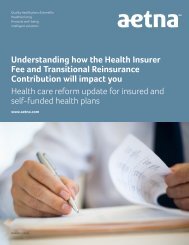
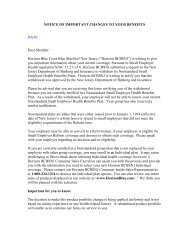
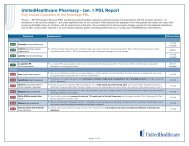
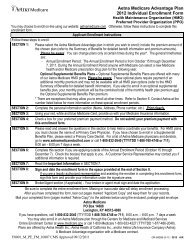
![[Letter Date] [First Name] [Last Name] [Street Address] [City, State ...](https://img.yumpu.com/49910635/1/190x245/letter-date-first-name-last-name-street-address-city-state-.jpg?quality=85)

